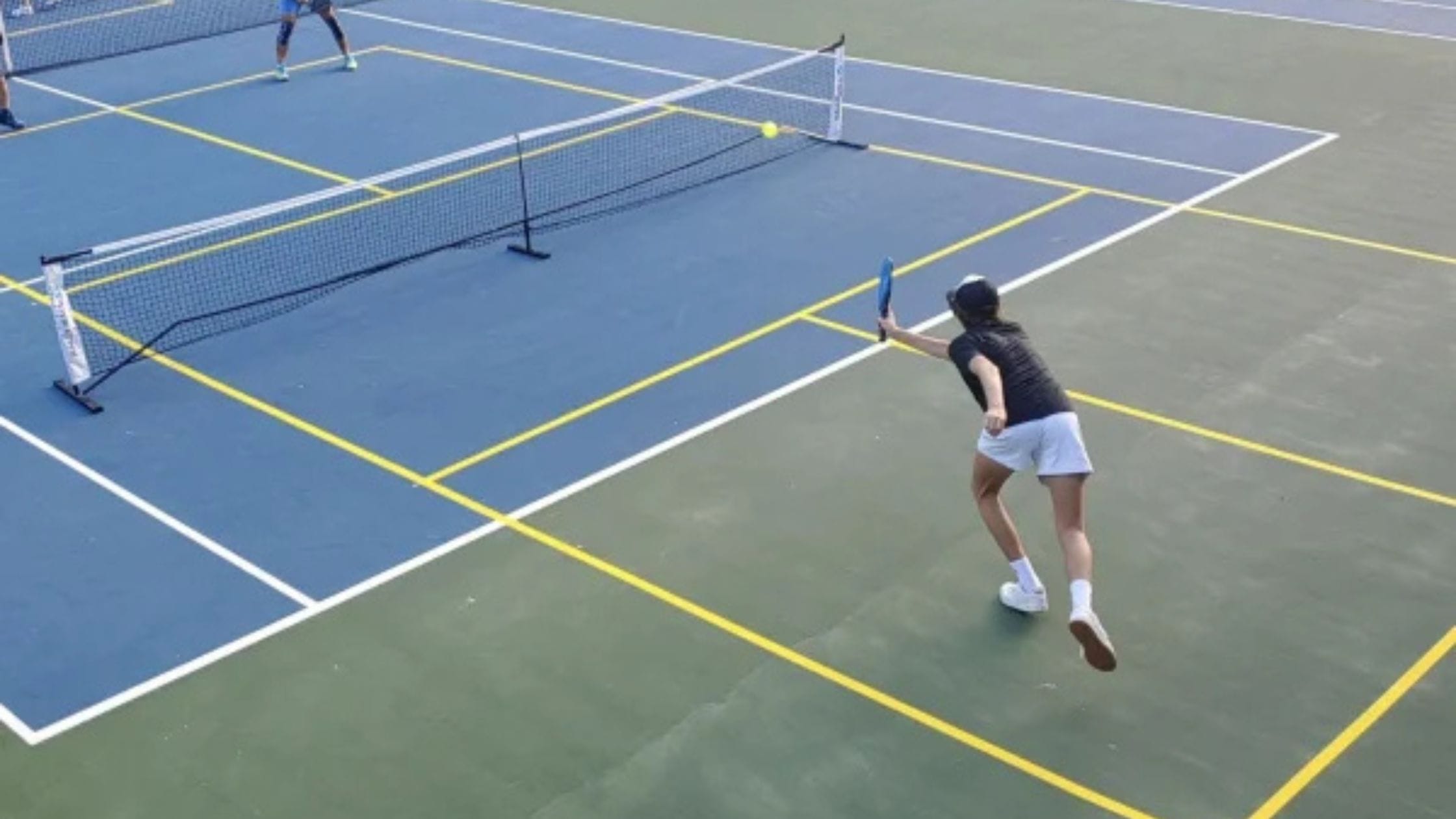Are you wondering how to start playing pickleball on a tennis court? Pickleball has exploded in popularity over the past few years. Parks, recreation centers, and private clubs are struggling to keep up with demand. If you have ever tried to book a spot on a pickleball court, you already know how difficult it can be.
Sometimes courts are fully reserved. Other times, club events take priority. Even if you manage to get there early, a swarm of eager players often fills every available space.
It can be frustrating when you just want to play, but you find yourself stuck waiting on the sidelines.
Fortunately, there’s a solution. Tennis courts are everywhere. They are usually easier to access, and most communities have more tennis courts than pickleball courts.
With a few simple adjustments, you can start playing pickleball on a tennis court without sacrificing the quality of your game.
It’s a great alternative when the dedicated pickleball courts are overbooked or unavailable. In this guide, you’ll learn exactly how to set up a pickleball court on a tennis surface.
You’ll also understand why tennis courts are an ideal backup option and how to make the transition smooth and enjoyable.
The Growing Problem of Crowded Pickleball Courts
Pickleball is no longer a niche sport. It’s mainstream. According to USA Pickleball, millions of players now compete regularly. This surge in interest has created a supply problem.
Many cities and private facilities have not yet caught up with the rapid rise in demand. A typical scenario involves waiting lists, crowded courts, and long delays between games.
If you’re lucky enough to belong to a club, you might still find certain hours reserved exclusively for club play or tournaments.
Even public courts often operate on a first-come, first-served basis, leading to competition for spots.
These issues make it hard to get in a solid practice session or enjoy a game without feeling rushed.
Suggested reading: A Beginner’s Guide to Playing Pickleball in Santa Cruz
Why Tennis Courts Offer a Great Alternative for Pickleball Players
Tennis courts offer a practical and convenient solution. First, they are plentiful. Most parks and recreational facilities have more tennis courts than pickleball courts.
Second, tennis courts often sit empty, especially during weekdays or off-peak hours. You may not even need to reserve them.
Lastly, tennis courts provide an excellent playing surface that matches the requirements for pickleball. Their hard, flat surface is perfect for a game of precision, strategy, and quick reflexes.
With minimal effort, you can turn an underused tennis court into a thriving pickleball arena.
Suggested reading: The Future of Pickleball in Santa Cruz: New Court Locations
How to Set Up a Pickleball Court on a Tennis Court Using Chalk
If you’re ready to start playing pickleball on a tennis court, the first step is marking your court layout. Chalk is the easiest and most affordable tool for this job.
You’ll need to outline the boundaries of a pickleball court inside the tennis court. A regulation pickleball court is 44 feet long and 20 feet wide.
Start by measuring and marking these dimensions on one side of the tennis court. It helps to begin near the tennis net, where you’ll also use or adjust the net for pickleball height.
Once you’ve marked the four corners of your court with chalk dots, connect them with clear, straight lines to create the outer boundaries.
After the perimeter is set, move to the non-volley zone, commonly called the kitchen. Measure 7 feet from the net on both sides. Draw a line parallel to the net to mark the kitchen boundary.
Finally, draw the centerlines that split the service courts on each side into left and right sections. These lines run perpendicular from the kitchen line to the baseline at the back of the court.
When finished, you should have a complete, clearly defined pickleball court layout within the larger tennis court.
How to Adjust the Net on a Tennis Court for Pickleball Play
A standard tennis net stands higher than a pickleball net. Tennis nets are 42 inches high at the posts and 36 inches at the center.
For pickleball, the ideal net height is consistently 34 inches at the center and 36 inches at the sidelines. If you’re playing on a tennis court, you have two options.
One is to lower the tennis net manually by loosening it or adding a strap at the center. Some tennis nets have adjustable centers for this purpose.
The second option, which many players prefer, is to bring a portable pickleball net. These nets are lightweight, easy to set up, and already match regulation height.
Once your net is in place and the court lines are marked, you’re ready to play.
Understanding the Basics of Playing Pickleball on a Tennis Court
The rules of pickleball remain the same whether you’re playing on a dedicated court or a tennis court conversion.
Serve underhand, diagonally across the court, from behind the baseline. After the serve, both teams must let the ball bounce once on their respective sides before volleys are allowed.
This is known as the two-bounce rule. Players should avoid standing in the kitchen unless the ball bounces there first.
Scoring is simple, with points awarded only to the serving team. Games are typically played to 11 points, and you must win by at least 2 points.
Playing pickleball on a tennis court doesn’t change the game’s pace or enjoyment. However, it may offer more space around the court’s edges, allowing for extra room to move or spectate.
It’s also important to remain courteous when sharing the tennis court with others, especially if you’re playing during traditionally busy tennis hours.
How to Navigate Shared Use Between Tennis and Pickleball Players
Tennis players and pickleball players often need to share facilities, especially when courts are limited.
If you are playing pickleball on a tennis court, it’s essential to respect existing reservations and be courteous to others.
Many parks and clubs post schedules for tennis and pickleball use. Always check these schedules before setting up your pickleball game.
If no formal schedule exists, it’s helpful to communicate directly with other players on-site to coordinate playing times.
Keeping chalk markings neat and cleaning up after your game demonstrates respect and ensures continued access for everyone.
Why Chalk Lines Are the Best Temporary Solution for Tennis Court Pickleball
Temporary chalk lines are the easiest and most respectful method for marking pickleball courts on tennis courts. Chalk is highly visible, inexpensive, and washes away with rain or a quick scrub.
This makes it ideal when you’re sharing space with tennis players who prefer the court left as it was. Chalk allows you to set up your court quickly and remove the markings when finished.
Tape is another option, but it can leave residue or damage the court surface. Many clubs and parks prohibit permanent markings on shared tennis courts, making chalk the go-to option.
How to Transition from a Tennis Game to Pickleball Without Hassle
If you’re a tennis player new to pickleball, the transition might feel strange at first. The pickleball court is smaller, requiring less running but more finesse and precision.
Unlike tennis, pickleball emphasizes control over power. Short strokes and dinking close to the net are critical strategies.
The serve is always underhand in pickleball, which can feel awkward for former tennis players.
However, once you become familiar with the rhythm of the game, you’ll find pickleball offers a fun, fast-paced alternative that’s just as rewarding as tennis.
Managing Crowded Pickleball Clubs with Tennis Court Play
Many pickleball clubs are now so popular that securing a spot can feel like a competitive sport in itself. Club days often dominate schedules, leaving casual players scrambling for open times.
Weekends are especially crowded, with lines of players waiting for a game. If you don’t arrive early, you may miss your chance altogether.
Playing pickleball on a tennis court helps solve this problem. Even if you’re not part of a formal pickleball club, you can set up and play on a tennis court whenever it’s available.
This flexibility helps you avoid the overcrowded club scene and enjoy the game on your own schedule.
What to Bring When Playing Pickleball on a Tennis Court
Before heading to the tennis court, make sure you have everything you need for a successful game. Bring your paddles and pickleballs, which are different from tennis balls.
If you plan to adjust the tennis net, bring a strap or cord to lower it properly. Chalk is essential for marking your lines. If you prefer not to use the existing tennis net, bring a portable pickleball net.
Comfortable court shoes, water, and sun protection are also recommended, especially if you’re playing outdoors in the heat. Preparation makes the transition smoother and ensures a fun experience.
Suggested reading:
- Best Men's Pickleball Shoes: Top Picks for Performance & Comfort
- 10 Best Pickleball Paddles 2025: Find Your Perfect Paddle
Why Playing Pickleball on a Tennis Court Builds Community
Playing pickleball on a tennis court often draws attention from passersby. It sparks curiosity and invites new players to try the game.
You might find tennis players who want to give pickleball a shot after watching a few rallies. By using tennis courts for pickleball, you’re helping to expand the sport’s reach and create a more inclusive environment.
Pickleball is known for its social nature, and playing on shared courts only enhances that sense of community.
Suggested reading: Pickleball Strategies for Doubles: Never Lose Again In Doubles
Final Thoughts On playing pickleball on a tennis court
Playing pickleball on a tennis court is an easy and practical solution for those struggling to find available pickleball courts.
With crowded club days, reserved courts, and long waiting lists becoming the norm, tennis courts offer a reliable alternative.
With a piece of chalk and a little effort, you can set up a court in minutes and enjoy a game without the stress of fighting for space.
Whether you’re a seasoned player or just starting out, this method ensures you can keep playing and improving your game.
Grab your paddles, mark your lines, and enjoy the game on a tennis court near you.




